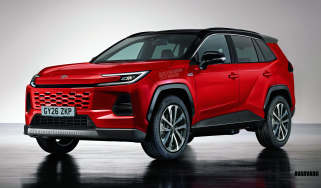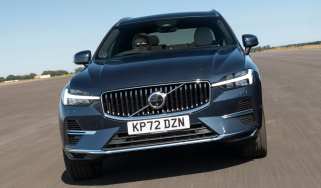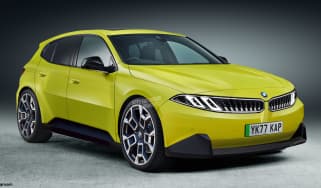Best plug-in hybrids to buy 2025
The plug-in hybrid market has grown exponentially in recent years. Here are our electrified favourites
Not everyone is ready to take the plunge and buy a fully electric car, which makes plug-in hybrids (PHEVs) a great ‘stepping stone’ option. These cars combine an internal combustion engine with electric power just like every other hybrid car but, as the name suggests, you can charge them from a plug, just like a regular EV.
The bigger battery and plug-in charging give plug-in hybrids a long EV range with many models now officially able to go over 60 miles on electric power alone. This means that owners who can charge at home or at work and never exceed the pure-electric range can use next to no fuel in everyday driving. Then, on longer trips there’s no range anxiety because you can use the internal combustion engine (ICE) and refuel as you would a petrol or diesel car.
The plug-in hybrid sounds like the best of both worlds but it isn’t quite as simple as that. Because they effectively have two powertrains - one petrol and one electric - PHEVs can be heavy and expensive. The weight affects fuel economy when you do use the ICE and, together with the price, means that plug-in hybrid tech tends to be offered in larger cars.
Our expert road testers have thoroughly tested every PHEV on sale in the UK, and using their verdicts we’ve rounded up the best plug-in hybrid cars to buy right here. We’ve given you a broad cross-section of what’s on offer including the top models available of each type from SUVs to executive saloons and estates.
| Rank | Model | Price from | Rating out of 5 | Max. WLTP combined EV range |
|---|---|---|---|---|
| 1 | BMW 530e | £62,500 | 4.5 | 63 miles |
| 2 | Mercedes C 300 e | £50,000 | 4.5 | 67 miles |
| 3 | BMW 330e | £47,000 | 5.0 | 62 miles |
| 4 | Toyota Prius | £38,000 | 4.5 | 53 miles |
| 5 | Hyundai Tucson PHEV | £39,000 | 4.0 | 38 miles |
| 6 | Kia Sportage PHEV | £40,500 | 4.5 | 43 miles |
| 7 | Skoda Kodiaq iV | £42,000 | 4.0 | 71 miles |
| 8 | Toyota RAV4 | £44,000 | 4.0 | 46 miles |
| 9 | Suzuki Across | £49,500 | 4.0 | 46 miles |
| 10 | Range Rover Sport P460e | £90,000 | 4.0 | 74 miles |
1. BMW 530e

- Prices from £62,500
- Maximum pure-electric range: 63 miles
Pros |
Cons |
|
|
The BMW 5 Series has long been a staple of the company car and executive car worlds, and the good news is that its loyal buyers can now reap the benefits of plug-in hybrid power. The BMW 530e may be partly electric, but it’s still just as enjoyable to drive as a 5 Series should be. It’s equally impressive inside, too, where you’ll find a class-leading interior that’s very well put together, ergonomically designed and filled with top-quality tech.
Unfortunately, the 530e’s plug-in powertrain does come at a fairly sizeable additional outlay compared with the combustion models, but its reduced running costs will help to mitigate this initial financial sting. Alternatively, if you’re thinking of making the jump to fully-electric motoring, there’s always the option of the BMW i5. If you’re sticking with PHEV for now, though, the 530e is a top choice that was officially crowned as our Premium Hybrid Car of the Year at the 2024 Auto Express New Car Awards.
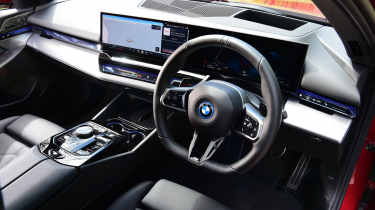
“The PHEV system has a slightly sluggish step off the line in its e-mode, so it doesn't feel as effortless as a BMW i5. Once rolling though, the 530e is staggeringly refined because of its ability to shuffle around in near-silence at town speeds.” – Alex Ingram, chief reviewer, road-tested the 530e in the UK.
The most compelling alternative to the 530e is BMW’s own i5, which throws out the petrol engine for an all-electric, very powerful and even more refined drivetrain. But another to consider is the somewhat unusual Mercedes E 300 de, which is actually a diesel plug-in hybrid, for potentially greater efficiency even when the battery is depleted. At nearly £68,000 it’s more expensive than the BMW, though
2. Mercedes C 300 e
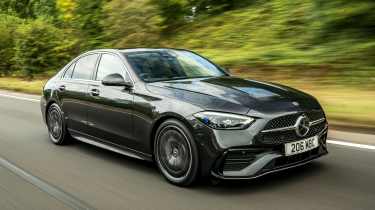
- Prices from £50,000
- Maximum pure-electric range: 67 miles
Pros |
Cons |
|
|
Much like the BMW 530e, the Mercedes C 300 e is another plug-in hybrid version of a traditional German executive saloon. This variant of the Mercedes C-Class offers a zero-compromise alternative for company car drivers who aren’t ready to go fully electric. It’s capable of driving up to 67 miles on battery power, so you’ll have to cover quite some distance before waking the 2.0-litre petrol engine.
Its styling has been influenced by Mercedes’ flagship S-Class, as has the interior that feels almost as plush as the limousine’s. That car’s incredibly slick and intuitive MBUX infotainment system is fitted, too, displayed on a fantastic 11.9-inch touchscreen that’s standard on every model.
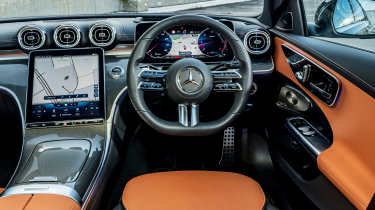
“With a superb electric-only range and strong performance from the motor, many drivers could realistically use this as a full EV for the most part. Yet on longer journeys it benefits from its muscular ICE, great comfort and slick cabin tech.” – Alex Ingram, chief reviewer, road-tested the C 300 e in the UK.
You’ll find the Mercedes C 300 e’s closest rival, and most prominent alternative, next up in this list: the BMW 330e. A new arrival though is the Audi A5 e-hybrid, arriving in 2025 from around £50,000 with a 295bhp plug-in hybrid setup and up to 67 miles of EV range, matching the Merc
3. BMW 330e
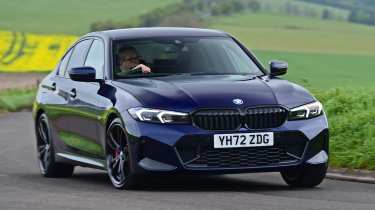
- Prices from £47,000
- Maximum pure-electric range: 62 miles
- Best driving experience
Pros |
Cons |
|
|
It may not be the most futuristic or innovative model, but the BMW 3 Series is a brilliant all-rounder, with the plug-in hybrid 330e serving as the top choice in the range for company car drivers. The 330e is just as enjoyable and engaging to drive as any other 3 Series, with its 2.0-litre four-cylinder petrol engine and electric motor working in harmony to deliver plenty of pace.
If you’re eyeing up the 330e as a potential family car, the good news is that the cabin and boot aren’t really intruded on by the PHEV powertrain’s components. Four tall adults will be able to sit comfortably in the BMW’s plush seats, and with 375 litres of boot space on offer, you'll be able to load up the weekly shop without any complaints.

“The BMW 3 Series – and in particular this 330e plug-in hybrid – really does represent the best of both worlds for those wanting to dip their toe into the world of electrification (and save on their tax bill)” – Richard Ingram, deputy editor, road-tested the 330e in the UK.
The Mercedes-Benz C 300 e slightly further up will probably catch the eye of anyone shopping for a plug-in compact executive car, as will the upcoming Audi A5 e-hybrid, though depending on how important the ability to top up with fuel is, pure EVs in this class include the Tesla Model 3, Hyundai Ioniq 6, BYD Seal, and Polestar 2 – plus BMW’s own (and excellent) i4
4. Toyota Prius
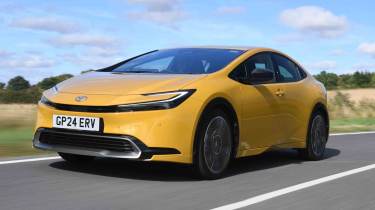
- Prices from £38,000
- Maximum pure-electric range: 53 miles
Pros |
Cons |
|
|
The Prius has been offered as a plug-in model since its third generation, but in the UK the latest version of Toyota’s seminal hybrid is plug-in hybrid only. We’re not complaining though, because while a regular hybrid would surely be pretty efficient on its own, the latest model uses its larger battery to good effect.
Not just in terms of efficiency either, though there’s the usual caveat to give on claimed economy of well over 500mpg: you’ll need to maximise your time in pure EV mode for figures like that, and the Prius will happily do a real-world 40 miles or so between charges. But the plug-in is also the most potent Prius offered worldwide, with 220bhp at its disposal, for genuinely quick performance – 0-62mph comes up in only 6.8 seconds.
It’s pretty good in the corners too, certainly compared to previous versions of the Prius, and while it has some of the same compromises - such as an unusual and not always intuitive dashboard layout, and reduced practicality thanks to the sloping roof - excellent real-world efficiency and Toyota’s reputation for longevity more than make up for it.
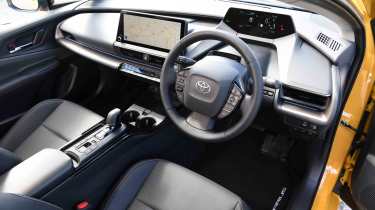
“You’re unlikely to get close to the headline 564.9mpg, but you should still manage to achieve better fuel economy figures than you could in a traditional petrol or diesel car – we saw more than 80mpg even when the car’s battery was depleted” – Alex Ingram, chief reviewer, road-tested the Prius in the UK.
There aren’t many direct equivalents to the Prius, though you’ll find similar pricing and EV range from some of the models elsewhere on this page. One to consider though is the Volkswagen Golf, whose plug-in version has a frankly spectacular 88 miles of EV range, and at around £36,000, slightly undercuts the Prius in the showroom
5. Hyundai Tucson PHEV
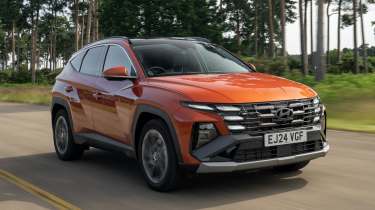
- Prices from £39,000
- Maximum pure-electric range: 38 miles
- Best for families
Pros |
Cons |
|
|
It’s no secret that we’re big fans of the Hyundai Tucson, as this distinctive family car has bagged our Mid-size SUV of the Year award for four years in a row. Not only does it look like a far more expensive car on the outside, but the Tucson’s on-board kit and build quality are right up there with the best, too.
There are a number of powertrain options available, but opting for the plug-in hybrid model will bag you 38 miles of purely-electric range and CO2 emissions as low as 29g/km. It’s even reasonably quick with 249bhp on tap.
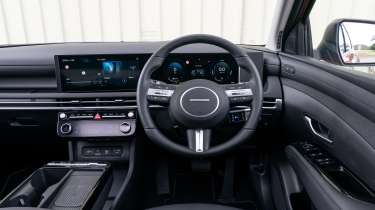
“Efficiency-boosting hybrid technology and high levels of standard equipment can be found throughout the range, while the interior is one of the roomiest in the class and the boot is large enough to rival those of estate cars.” – Ellis Hyde, news reporter, drove the Tucson PHEV in the UK.
Cast your eyes further down the page and the Kia Sportage PHEV is a more or less direct equivalent of the Tucson, and equally worthy of your attention, especially as it goes a touch further on a charge. Likewise, the Skoda Kodiaq iV, Toyota RAV4, Suzuki Across, Nissan Qashqai e-Power, and Honda CR-V e:PHEV (the latter at around £49k) are all compelling alternatives
6. Kia Sportage PHEV

- Prices from £40,500
- Maximum pure-electric range: 43 miles
- Longest standard warranty
Pros |
Cons |
|
|
Much like the Hyundai Tucson, we’re also very fond of its sister car, the Kia Sportage, as this is another mid-size SUV that delivers style and substance in equal measure. The bold, almost extra-terrestrial looks are complemented by a clean, modern interior design with two crisp 12.3-inch displays as the centrepiece. Kia’s infotainment system is excellent, as are the build quality and space inside.
Comfort and refinement are key strengths, but the Sportage PHEV builds on this with a 43-mile electric-only range. Starting at more than £40k makes this powertrain the most expensive variant in the Sportage range, so it might not be the ideal choice for private buyers. But company car drivers will benefit from the 25g/km CO2 figure.

“The most expensive plug-in hybrid model has more power at 248bhp, but has a bigger, heavier battery and standard four-wheel drive, so it doesn’t get from 0-62mph any faster than the full-hybrid’s 8.4 second time.” – Shane Wilkinson, senior content editor, drove the Sportage PHEV in the UK.
For a similar driving experience with different styling (though a shorter warranty, at five years rather than Kia’s seven), the Hyundai Tucson above is the closest equivalent, while the same other rivals also apply: Japanese models like the Toyota RAV4, Nissan Qashqai e-Power and Honda CR-V e:PHEV, and the talented Czech option, the Skoda Kodiaq iV which you can read more about below
7. Skoda Kodiaq iV
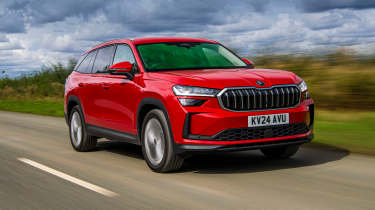
- Priced from £42,000
- Maximum pure-electric range: 71 miles
- Biggest boot
Pros |
Cons |
|
|
The Skoda Kodiaq is one of our favourite family SUVs, being one of those cars that seems able to do just about everything well, from its driving experience to its practicality and understated, handsome looks. The latest model also adds a genuinely luxurious-feeling interior and well judged interior tech with, we’re delighted to see, physical controls on both the steering wheel and dashboard.
It also scores a direct hit as a PHEV thanks to a seriously impressive 71-mile EV range. This is achievable in the real world, and if you’re out and about, can be topped up relatively quickly thanks to 50kW fast charging. The Skoda will be a popular choice as a company car too, because its 11g/km CO2 emissions and EV range of 70-plus miles mean a BIK rate of only 5 per cent, or 6 per cent in 2025/2026. It’s just a shame that to enable this, Skoda has had to sacrifice a seven-seat option, though the flip side to this is a vast 910-litre boot.

“If you’re able to keep the battery topped up, then there’s a high possibility that you could cover a day’s driving on electricity alone, although it’s reassuring to know that it’s backed up by the petrol engine.” – Dean Gibson, senior test editor, road tested the Kodiaq iV in the UK.
The £44k Cupra Terramar e-Hybrid is a touch smaller than the Kodiaq iV but uses the same 1.5-litre plug-in hybrid setup, and to similarly good effect, going 76 miles on its battery before the petrol engine kicks in. Likewise you can get plug-in versions of the VW Tiguan and larger Tayron, though the Skoda undercuts both on price. Otherwise, look at cars such as the Hyundai Tucson and Kia Sportage above, or the Toyota RAV4 and Suzuki Across below
8. Toyota RAV4
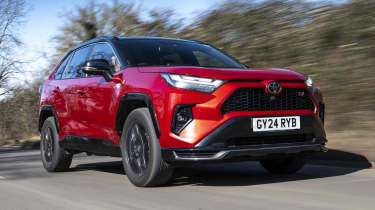
- Prices from £44,000
- Maximum pure-electric range: 46 miles
Pros |
Cons |
|
|
Toyota was a pioneer for mainstream hybrid power, and while full-hybrids are what the brand tends to be associated with, it also knows a thing or two about PHEV technology. The Toyota RAV4 Plug-in has a claimed fuel economy figure of up to 282.4mpg, and while it’s unlikely that you’ll see this in the real world, we still managed well over 60mpg when living with the RAV4 as part of our long-term test fleet. It’ll also cover up to 46 miles in pure-electric mode.
Inside, the design is rather conservative, but all the essential tech is present and straightforward to use. Toyota has a solid reputation for build quality, too, and the RAV4 was ranked as the fourth best car to own out of 50 models in our latest Driver Power survey. It was also crowned as the most reliable SUV.
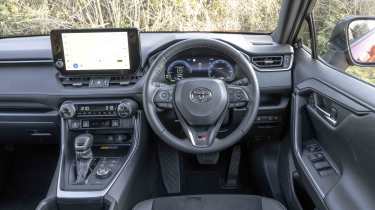
“The 0-62mph time is a hot hatch-rivalling six seconds exactly, although the tall body and the way the powertrain delivers this acceleration means it doesn’t feel particularly sporty.” – Dean Gibson, senior test editor, road tested the RAV4 in the UK.
Given it’s nearly identical, the Suzuki Across could be worth a look, the higher price potentially offset if you find a good deal, or even if you just have a good relationship with your local Suzuki dealer. Honda’s CR-V e:PHEV will likely prove similarly trouble-free to own and its 50-mile EV range is just ahead of the Toyota and Suzuki, while the Kia Sportage/Hyundai Tucson pair further up are popular choices
9. Suzuki Across
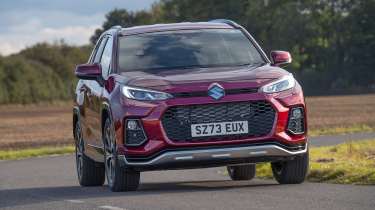
- Prices from £49,500
- Maximum pure-electric range: 46 miles
Pros |
Cons |
|
|
If you enjoy getting more for your money and are in the market for a plug-in hybrid, the Suzuki Across is almost a no-brainer. It’s basically a rebadged Toyota RAV4 PHEV, and while it’s more expensive to buy as a cash purchase, there are some very tempting leasing deals to be found. It may wear a different badge, but the Suzuki is just as quick, well built, easy to live with and spacious as the Toyota.
Just one trim level means standard kit is generous, while the powertrain sees a 2.5-litre four-cylinder petrol engine linked to a CVT automatic gearbox, with an 18.1kWh battery pack feeding an electric motor on each axle. As you might imagine, quality and driver appeal, plus cabin space and of course the feel and function of its plug-in setup, are all nigh-on identical to the Toyota.
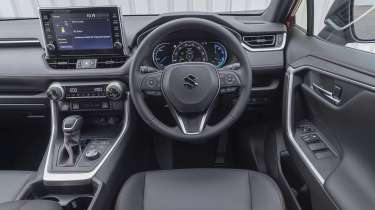
“The RAV4 is a car we like, so much of that fondness carries over to the Across. Quality inside is good with nice soft-touch plastics where you want them most and everything screwed together well – as you’d expect from a car built by Toyota.” – Steve Fowler, contributor, drove the Across in the UK.
If you’d not gathered by now, the Across is basically a rebadged Toyota RAV4, so that’s the first car to check out if you generally like the Suzuki but aren’t convinced by something, especially the higher price. Beyond that, take a look at strong sellers like the plug-in Kia Sportage and Hyundai Tucson, the Skoda Kodiaq iV, and Nissan Qashqai e-Power
10. Range Rover Sport P460e
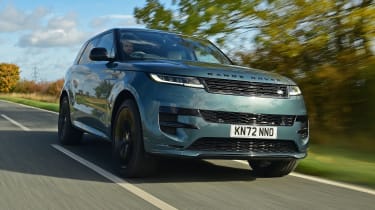
- Prices from £90,000
- Maximum pure-electric range: 74 miles
Pros |
Cons |
|
|
It’d be tempting to put the plug-in hybrid version of the fully-sized Range Rover on this list, but its Range Rover Sport sibling is very nearly as luxurious while also being cheaper and slightly sharper to drive, without significant detriment to Range Rover’s famous off-road ability.
The plug-in Range Rover Sport pairs a 3.0-litre in-line six-cylinder petrol engine with a whopping 38.2kWh battery pack. This gives an impressive theoretical electric range of up to 74 miles according to lab results, although we’d expect more like 50 miles in real-world conditions. The P460e is also good for 454bhp and 660Nm of torque, making for a 0-60mph time of 5.3 seconds, so it certainly lives up to the Sport name.

“The third-generation Range Rover Sport delivers exactly what luxury SUV buyers are looking for. Smarter styling, improved onboard technology, along with a raft of developments in the way the Sport drives mean that it remains as sophisticated as ever, while maintaining a dynamic edge over its bigger Range Rover sibling.” – Alex Ingram, chief reviewer, road-tested the Range Rover Sport in the UK.
It’s a few bob more than even the plug-in Range Rover Sport, but you can get a plug-in Bentley Bentayga these days and as such things go, it’s a very fine machine indeed. More on the Sport’s level though are cars like the BMW X5 xDrive50e, from around £82,000, or if you stretch the budget a bit, the hugely polarising but undeniably luxurious and capable BMW XM 50e, from £110,000.
Latest Range Rover Sport deals
How we choose the best plug-in hybrid cars
We’ve tested every plug-in hybrid on the UK market in a wide range of different driving conditions. Our road test regime for these vehicles pays particular attention to running costs and real-world efficiency because these are such strong motivational factors for buyers in this segment, who often run a PHEV as a company car.
As it’s usually medium to large SUVs, saloons and estate cars that are offered with the tech, we also pay particular attention to space and practicality in the cabin and the boot area, which can sometimes be compromised by the addition of the large battery pack.
A good plug-in hybrid will transition seamlessly between the electric power source and the engine, offering quick responses and strong performance. The inevitable extra weight of the complex battery and engine combination shouldn’t be too evident in the way the car corners and rides over bumps.
Our pick of the best hybrids cars on sale above are drawn from different sectors of the car market so they’re also rated in relation to other cars of their type that customers could buy with a similar budget - be they electric, full hybrid, petrol or diesel. If you’re set on a plug-in hybrid, though, these are the very best options currently on sale.
How you can choose the best plug-in hybrid car
The plug-in hybrid’s positioning as a halfway house between traditional petrol or diesel cars and full EVs has obvious appeal. It’s important for anyone considering a PHEV, however, to make sure that their particular lifestyle will mean they get the best, rather than the worst, of both worlds. Here are the key things we think you should consider…
Charging and running costs
To get the most out of a PHEV you have to charge it regularly and will preferably do lots of driving in EV mode.
Official fuel economy figures for these vehicles are routinely over 300mpg because they do the first part of the official WLTP tests in pure-electric mode. You won’t get anywhere close to that once the battery is flat, however. Our six-month long term test of a BMW 530e saw us average close to 70mpg which is excellent for a big executive estate car but nowhere close to the official economy figure of over 470mpg.
If you never exceed the electric range of a PHEV you will never use any fuel but once the battery is depleted on longer journeys, efficiency is likely to be worse than in an equivalent petrol car. That makes PHEVs a very cost effective option if you do lots of short trips with the occasional longer journey of 100 miles or more thrown in. If you rarely do longer journeys and have easy access to charging, a pure EV is worth considering. If you do lots of long distance miles, a full hybrid or mild hybrid may prove cheaper to run.
Company car tax on PHEVs is no longer as attractive as it once was but business users can still save handsomely, especially on cars that can cover over 70 miles on EV power alone as these qualify for the six per cent Benefit-in-Kind (BiK) tax rate. These days, you have to buy an EV to get the lowest tax rates.
Driving experience
The best plug-in hybrids offer the smoothness and refinement of an electric car around town together with strong performance from the electrically assisted petrol engine on the open road. The main drawback comes as a result of the extra weight which can make these vehicles feel more cumbersome on a twisty road than a conventional petrol or diesel car. Performance will also suffer when the battery is flat.
The top models disguise their weight well so look out for the way the car turns and settles over undulations on your test drive. It will also help to try the car in its different driving modes as a PHEV will feel very different in EV mode driving only on electricity than it does in hybrid mode where it uses a combination of the two power sources. Most PHEVs have a mode that saves the battery charge by running on petrol or diesel alone. Give this a go for some insight into how the car feels without electrical assistance.
If you’re buying a PHEV mainly for town driving, size could be an issue as lots of the cars using this technology are larger models. Make sure you feel comfortable turning and maneuvering the car in tight spaces.
Practicality
PHEVs effectively have two powertrains, electric motors and batteries for EV power and an internal combustion engine. All these components have to go somewhere and this can lead to small reductions in practicality compared to petrol cars or pure EVs. Check the size of the boot and make sure that any bulky objects you carry regularly, like pushchairs, bikes or golf clubs, will fit.
With batteries often eating into storage space in compartments under the boot floor, check that you’re happy with the options for storing the charging cables. If there’s no option other than having them in a bag in the boot, it can be inconvenient.
If you’re thinking of making the switch, read our list of the best electric cars to buy…






